Your Creative Writer Resume Guide: Tailored Tips for All Writers
With a creative writing degree in hand, there are many paths you can take in your career. But whichever you choose, you’ll have to convince your future clients or employers that you’re the best choice they can make. The key for that will be a killer writing portfolio and your creative writer resume.
In this post, we’ll go over the possible career paths you can choose as a creative writer. After that, we’ll show you how to create your creative writer resume in 5 easy steps, including some portfolio-building tips at the end.
Do creative writers need a resume?
Finding a job specifically titled “creative writer” is not very common. So comes the question: what job titles should I be looking for, and how do I create a resume for that?
Don’t worry, there are many directions to go in with a creative writing degree —and even if you’re interested in more of them, it won’t be too hard to tailor your creative writer resume for each.
Possible career paths and the need for a creative writer resume
Author
Becoming an author is probably the first one that comes to mind. However, it takes more than submitting some job applications and nailing your interviews. You’ll have to have a finished book ready to be pitched to publishing houses —or for self-publishing.
Either way, having an author website, a following on social media, and a really solid pitch will be more important than a resume in this case.
Content writer
As a content writer, you’d be writing long-form text for businesses. That could be in-house for just one company, or freelance for many clients.
For in-house positions, you’ll need a creative writer resume that lists your educational background, relevant work experiences (any writing-related jobs or tasks should go on there), and skills like excellent time-management, proofreading and editing, and even great research skills.
You’ll need it for in-house applications too, but if you want to try freelancing, having a strong portfolio of your content writing samples will be crucial. Clients will want to see your previous work to assess your writing skills and how well you pick up on the tone of voice of the brands you work with.
Creative copywriter
Being a creative copywriter can mean many things in itself: you could be an advertising creative working for an agency, or a freelancer crafting landing pages and email campaigns for clients on their own. Or, you could also work in-house, providing one company with all the different kinds of copy they might need.
Similar to content writers, a “show don’t tell” approach works best for getting hired. We recommend creating a copywriting portfolio website, and adding your creative writer resume on there: either on the about page or its own separate page.
In your resume, mention your experience with marketing and advertising, and highlight skills like out-of-the-box thinking, problem-solving, creative writing, and communication.
Professor of English/creative writing
If none of these options sounded good to you, as it really is the craft of writing and literature itself that you love, don’t worry. Continuing on with an MFA and a PhD is always an option. Then after getting your degree, you can stay in academia to become a professor of English or creative writing.
In this case, your publications –whether they’re in literary journals, on blogs, or published otherwise–, will be the most important things to showcase. In your creative writer resume, you should focus on your educational background (as you’re staying in academia), and find a way to list your most impressive publications alongside your work history.
You can still create a sort of portfolio or author website to keep all your work together. With a writer website builder like Copyfolio, you can set up a simple website within minutes, adding your publications as either links, PDFs, or writing more about them on separate project pages.
How to create a creative writer resume in 5 steps
Writing about yourself and making your creative writer resume might seem like a daunting task, but we’ll try to make it easier. As with everything, if you break it down into smaller steps and you go one by one, it won’t be that intimidating anymore.
We did just that for this topic: we’ll walk you through how to create your resume in 5 easy steps.
Step 1: Assess the expectations & choose a format
The very first thing you need to do is check what the job post you’re applying for says. It could be a freelancer gig or a traditional job ad, but either way, you’ll have to read through it carefully, looking for:
- The tasks and responsibilities you’ll be expected to do and have
- The educational background and work experience they need
- The skills they expect from you
- Anything that is not a must but “is a plus or preferred”
Copy and paste them somewhere or make a list for yourself, so when you’re putting your creative writer resume together (or tailoring an existing one for the position), you’ll know what to mention or highlight in there.
The secret to a great resume is taking these requirements and reflecting on them in your CV.
Step 2: Write about your educational background
Once you know the expectations, it’s time to sit down and start writing: let’s start with your education. How much of an emphasis you should put on it will depend on the position you’re aiming for.
If it’s one of those experience/skill-heavy careers like content writing, just a short mention of your highest degree will do. For example:
2014-2018
Creative Writing, B.A.
Columbia College Chicago
If you’re at the start of your career or staying in academia, elaborating more on your educational background would be a good idea. List both your undergrad and postgraduate degrees, and write short summaries for each.
Mention what classes you took and enjoyed the most, and what topics you wrote your top assignments on. You can write about being on related committees and any other extracurriculars that are interesting enough to help get you hired.
Step 3: List your work experiences
The second section you’ll need to write will be the one about your work experience. There are two ways you could approach this.
One would be the traditional reverse-chronological method, where you list all your relevant jobs, starting from the most recent one, going back in time. The other option is using the functional format, where you list the type of tasks/skills you’re good at.
Whichever option you choose, the most important thing for either will be writing descriptions. Because you can say that you were a creative writer at this company, or that you’re good at writing landing pages, but that alone won’t impress anyone.
So try to bring in some facts and numbers, to show the impact of your work, and give more insights into the specific skills that the job taught you. For example:
July 2017 - August 2019
Creative Copywriter at This Amazing Company
- Crafted and optimized landing and sales pages with an average conversion rate of 25%
- Wrote SEO-optimized transactional blog posts that all rank in the top 10 on Google and have above 10% conversion rates
- Posted on the social media profiles of the company, driving engagement levels up by 35%

An online creative writer resume example, created with Copyfolio
Step 4: Highlight your skills
With work and education checked, it’s time to write about your top skills. Ideally, you would have touched upon them in the previous two sections, but it never hurts to list them again. Especially if you’re applying for in-house jobs —Applicant Tracking Systems scan this section for a reason.
When you get started with these, you should check back to the job post you’re applying to again. See if they list skills they expect the ideal candidate to have, and select the ones you also have. Make sure you add them to the top of your list.
Read through the list of your skills at the end and check if you have a good mix of hard technical and soft skills, as they’re both important.
Skills to showcase in your creative writer resume
To give you some ideas, here are some skills you could add to your resume as a writer (apart from the obvious “writing skills”):
- Proofreading and editing
- Research skills and data processing
- Advertising campaign planning and creation
- Marketing skills: lead generation, email marketing
- Conversion copywriting
- Search engine optimization
- Using software of the Adobe Suite
- Social media skills
- Creative, out-of-the-box thinking
- Time and project management, keeping up with deadlines
Step 5: Add your portfolio link & contact information
And lastly, let’s put the cherry on top: add your contact information (including your LinkedIn profile) and portfolio link to the header of your creative writer resume. These are crucial so that recruiters can check out more of your work and get in touch with you if you piqued their interest.
Some people swear by writing a resume summary or objective as well. That’s basically a paragraph underneath the header or contact information, summing up your expertise and detailing your motivation for applying for the position. Its aim is to catch the attention of recruiters —but some of them skip tend to skip this section to go skim the rest of the CV.
Create your creative writing portfolio with Copyfolio!
Linking your writing portfolio alongside your contact information is essential to be able to show your expertise after telling them about it in your creative writer resume. Because while you might state that you have exceptional writing skills and that the pages your write are compelling… it’s always different to actually see those skills in action.
The aim of a creative writer portfolio is to showcase your writing samples, demonstrate your writing style and skills, and give people a better idea of the types of projects or topics you’re most familiar with. These portfolios are almost always online portfolio websites, with the writing projects displayed mostly as pages or PDFs.
How to easily create a creative writing portfolio
The key to creating a portfolio website easily is finding the right tool. One like Copyfolio, that’ll provide you templates to start with, global design options for faster design changes, as well as prompts and guiding questions so you know what to write where.
Need some inspiration? Check out some amazing creative writing portfolio examples!
Create an account and choose a template
The first step is creating your account and choosing a template to start with. Browse through them to see which one catches your eye first.
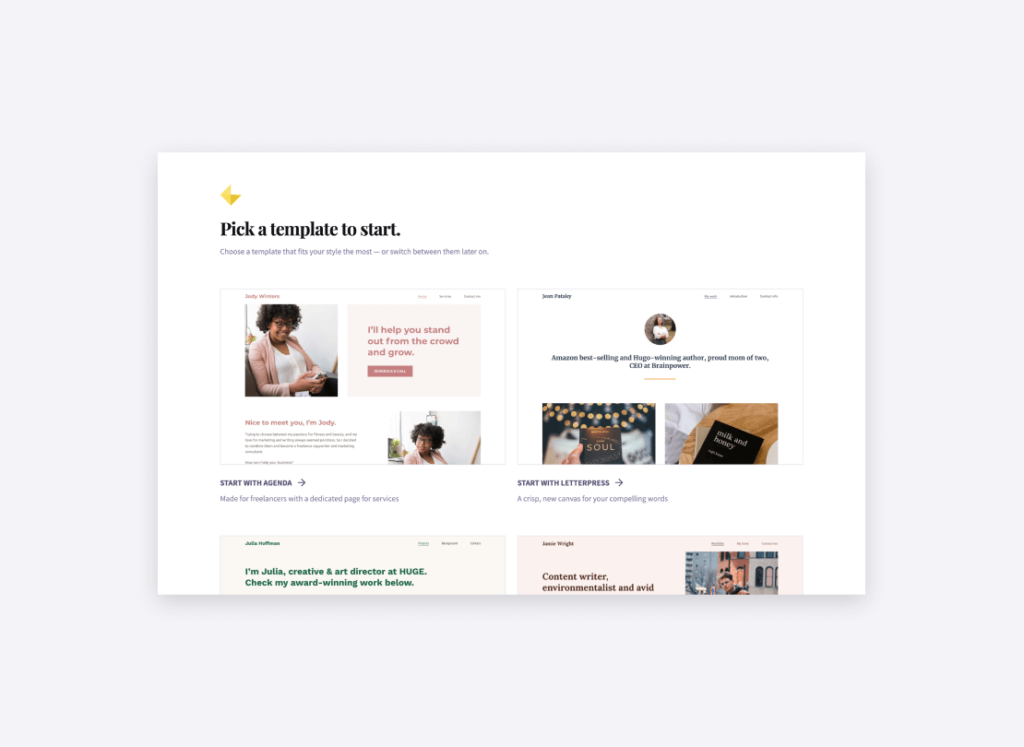
You won’t have to commit at that point —you can check them in more detail, scrolling through their homepages in the preview window.
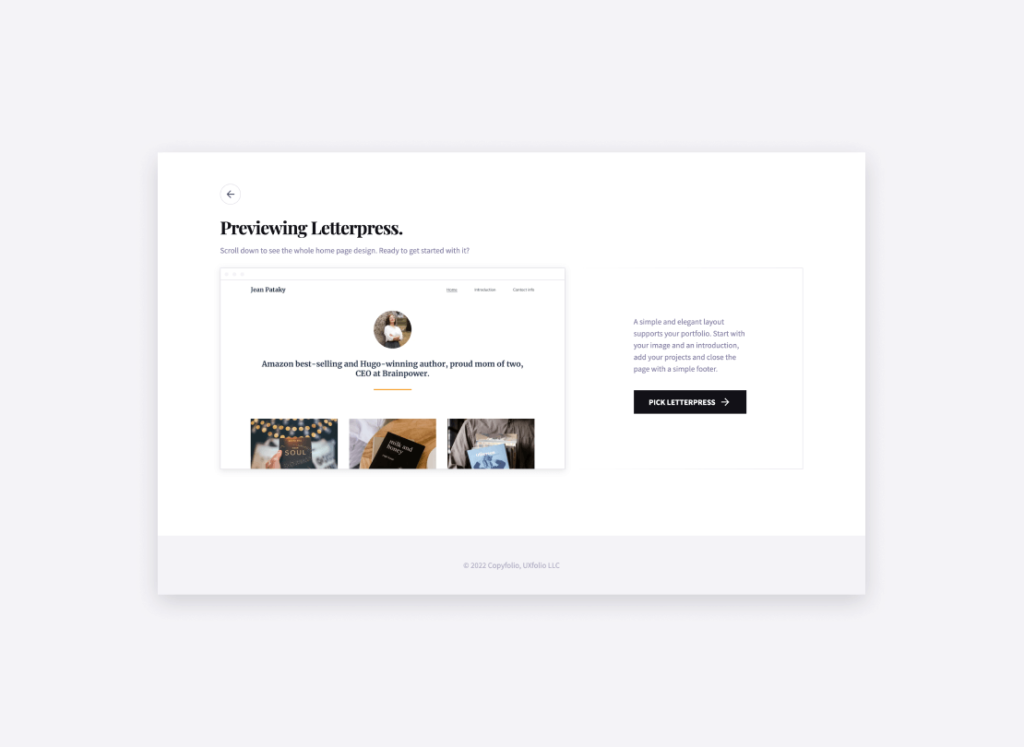
To make setting up your site even quicker, you can even select pre-built sections to add to your homepage right as you create your site.
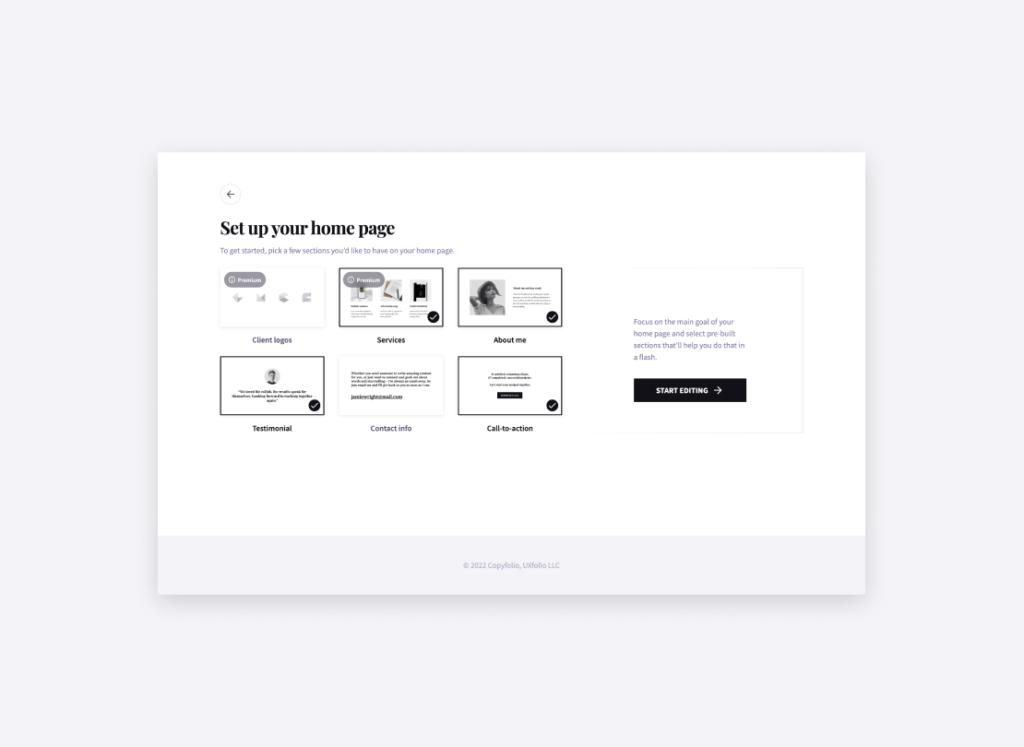
Fill out the sections on your homepage
Follow the examples or prompts in your homepage sections, and rewrite the text to be about you.
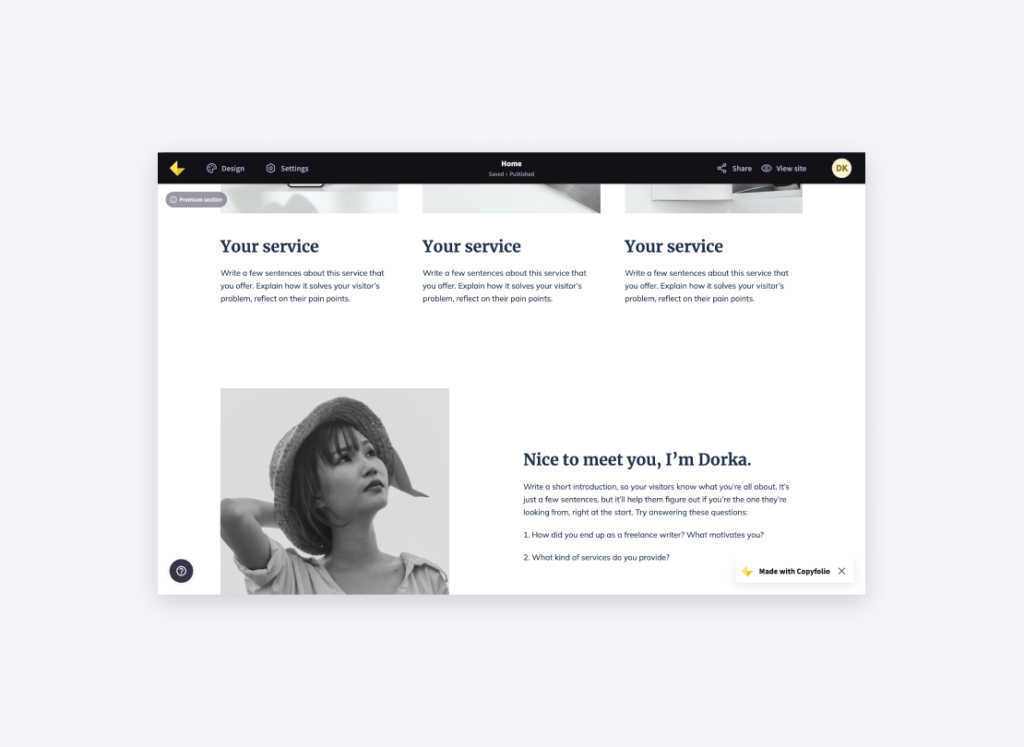
Did you remember other things you’d like to add here too? Just click on the little “Add section” buttons between sections and explore the other ones we have.
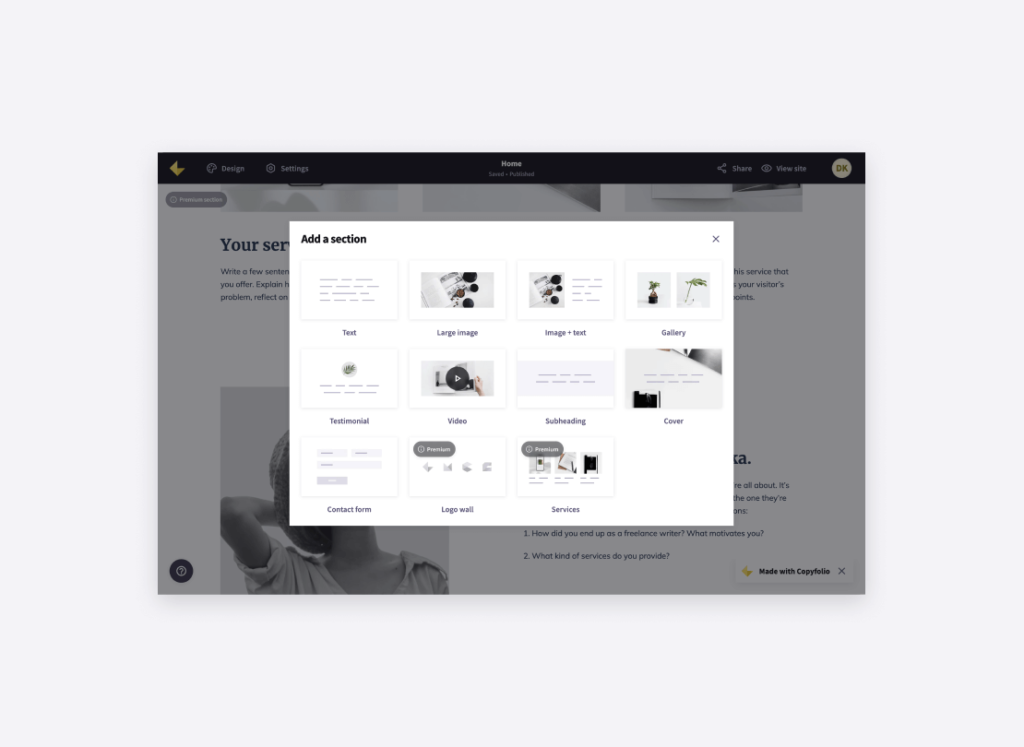
Add your writing samples as projects
Next, add your writing samples to your page. You can do that by clicking the “Add project” button towards the bottom of your homepage.
Choose between creating a new page, uploading a PDF file, or adding an external link. Whichever you choose, they’ll be available through the thumbnails the Copyfolio creates on the page.
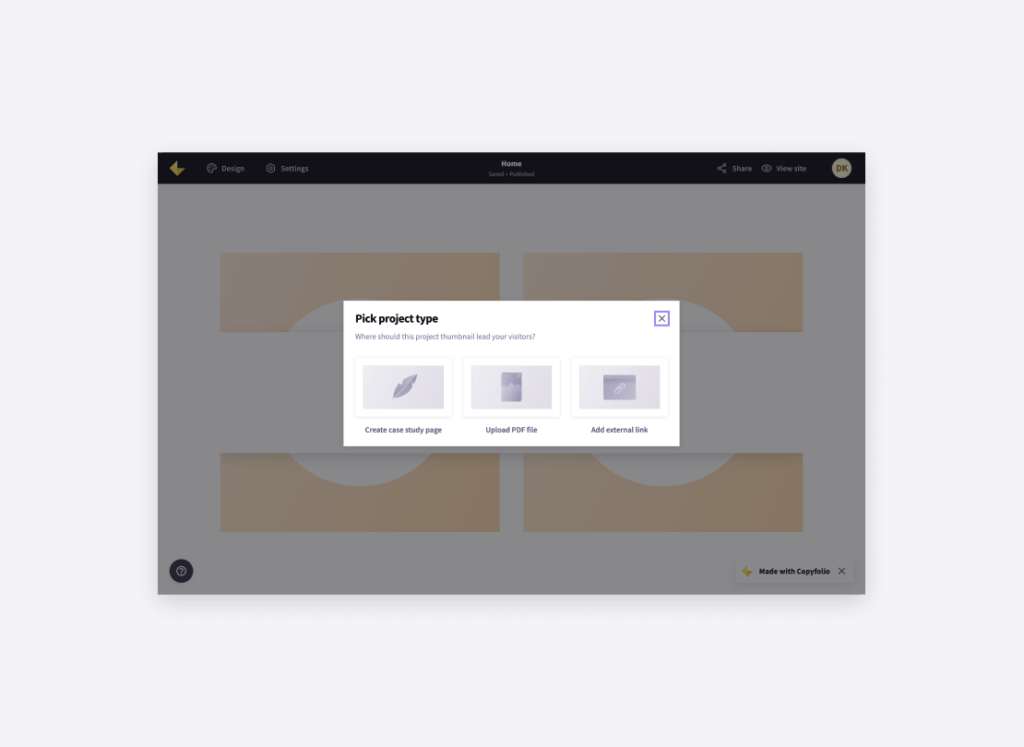
If you choose to create a new page, you’ll find prompts and guiding questions waiting for you. Follow and answer them for writing a case study that recruiters will love.
Once you’re done, hit publish and add your other samples the same way. Be careful, if it’s not a page but a PDF or link project, you’ll still have to publish them. Otherwise people won’t actually see them on your site.
Complete your about and contact pages
This step shouldn’t take too long: write a little bit about yourself on the former, and add your contact information or a contact form to the latter. Stay consistent with your style of writing throughout the entire site, and leave clear CTAs for your visitors everywhere along the way.
Share your portfolio with the world
That’s it, you’re done! You now have a complete portfolio website. All that’s left to do is share the link to your portfolio with everyone. As we said, you should have it in your creative writer resume, as well as on your social media profiles, and in your email signature.
Do you have an hour to create your portfolio? Click here and get started for free with Copyfolio!




